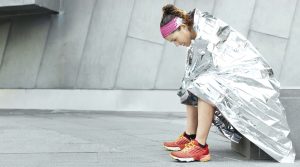We have all been there. It’s the middle of the race and the sun is beating down — you look at your watch and wonder why your heart is beating out of your chest at such a slow pace. You may think: “Did I overestimate my fitness?” Suddenly, the internal dialogue ceases as you look around at the carnage. Your fellow competitors appear to be going through the same struggle.
Fortunately, with a general understanding of how the body deals with heat, and knowledge of how to enhance certain physiological responses that promote cooling, you and your athletes will be ready to improve performance during steamy training days and hot races.
Why heat impacts performance
The human body is designed to function within a narrow range of internal temperature (98.6 to 103 degrees Fahrenheit, or 37 to 39.5 degrees Celsius). If the core rises above this range, it enters heat stroke territory and the body adjusts to protect itself.
As internal temperature rises, blood is routed away from working muscles and transferred towards the surface near the skin in order to dissipate heat, sweat production increases, and the central governor kicks in to protect athletes from pushing too hard and doing permanent damage to their brain and internal organs.
In this way, the body really has two strategies for dealing with heat: boosting the evaporative cooling effect (mostly via sweating) and limiting the intensity that athletes exert. With training acclimatisation, athletes can dramatically improve in each of these areas to perform better in the heat.
How to acclimatise
To better manage heat, athletes need to undergo hyperthermic conditioning. This is a technical way of saying that they need to raise their core body temperature during training in order to spur adaptations that will allow them to improve performance in hot conditions. To do this, they need to gradually increase their training volume in high temperatures.
Typically, it takes about 10 to 14 days of training in hot weather to incite measurable adaptations. This is why it is recommended that athletes show up to hot races well in advance. Starting with short, easy sessions of 30 minutes and gradually increasing the duration by 10 or so minutes per day is a safe approach to ensure that they adapt well without risking heat related illness, such as heat exhaustion or heat stroke.
It is also important to reign in intensity on hot days and to be extra-vigilant replenishing lost fluids and electrolytes. During training, consuming fluids with electrolytes (e.g. sports drinks) at a similar rate to fluid loss is beneficial, and should be viewed as essential during workouts lasting 90 minutes or more. When not working out, it is important to drink to thirst. A good gauge of hydration is to examine the color of urine. It should be straw colored — not deep yellow — which is a sign of dehydration, and not perfectly clear, which is a sign of overhydration.
Apart from intelligently training in hot conditions, there is also evidence that a sauna regimen can spur positive heat adaptations. Various studies have shown an improvement in time to exhaustion, an increase in blood plasma volume, a boost in sweat efficiency and improved cooling ability for athletes who undergo a sauna protocol. Evidence shows that 10 to 15 sessions lasting 20 to 30 minutes directly after exercise is sufficient for improving heat tolerance and boosting endurance, with studies demonstrating non-trivial improvements for cyclists as well as runners.
Racing in the heat
The likelihood of setting a personal best on a hot day is small, and it’s important for athletes to alter expectations. The single most important adjustment athletes should make racing in heat is to lower the target effort. Heat and humidity themselves force athletes to slow down, as does subsequent dehydration (which is especially relevant to long course racing). Blindly adhering to pacing goals is a recipe for disaster.
Instead, athletes should rely more heavily on rated perceived exertion and heart rate within the race, both of which will be higher than on mild days. When it’s hot, it is important to peel back the pace to avoid a late-race blow-up or, even worse, a medical emergency.
Although everyone is subject to the same conditions on race day, not everyone will respond in the same manner. All other things being equal, those who know how to disperse heat during the race will outperform competitors who do not. When racing in heat, the top two priorities should be:
- To consume fluids and electrolytes at appropriate rates; and
- To maximize the evaporative cooling effect.
Depending on race duration and intensity, most athletes should be able to consume 16 to 32 ounces of fluid per hour along with 600 to 1,200 mg of sodium. If possible, replacing fluids at the rate they are lost is ideal; however, this is often not practical. On a particularly hot day, or if an athlete is a heavy sweater, it may be impossible to consume fluids at this rate without experiencing stomach distress. In these instances, replenishing to the extent possible should be the goal.
Apart from external conditions, the ability to absorb fluid is governed by exercise intensity. When racing at a higher percentage of aerobic capacity (as in races that last under 90 minutes), it’s much more difficult to adequately process fluids than it would be during a longer race where intensity is lower. During shorter races, it makes sense to drink slightly less. To find the perfect medium between fluid and electrolyte intake at various intensities and durations, it’s important to experiment in training in order to establish an ideal hydration protocol for an athlete’s unique physiology.
Maximizing the evaporative cooling effect
Apart from hydrating and adjusting pace, an incredibly important component of performing in heat is maximizing the benefit of heat dissipation. The body aims to do this naturally through sweating. During perspiration, pores open, blood is moved closer to the skin and moisture is sent to the surface. The subsequent evaporation lifts away heat, inciting cooling. The more evaporation an athlete can achieve, the cooler he/she will be.
To maximize this effect and remain as cool as possible, it’s important to use all available tools. In high humidity, the moisture in the air prevents the evaporation of liquid, thereby making it harder for the body to dissipate heat. This is why the combination of heat and humidity is worse than just heat and it becomes even more important to adjust pace and take measures to cool the body.
During hot and humid races, this means dumping water all over the body and using whatever else is offered on the race course. It is common for volunteers to hand out cold sponges or ice at aid stations, and a smart athlete should use all of these. This means dumping ice down his/her jersey or underneath a cap and sliding a couple of cold sponges into the chest area of the tri suit. In most cases, it is well worth slowing down at aid stations to grab these items. Striving to stay cool from the outset will pay off in the latter stages of races and any time lost slowing down to cool down will be regained.
Conclusion
Training and racing in the heat can be tough; however, we all face the same conditions on race day. By being prepared, intelligently acclimatising to the heat beforehand, and having a plan to keep cool, smart athletes will be able to manage heat better and will carry an advantage over competitors who are less thorough.
Article Credit – Conrad Goeringer, www.trainingpeaks.com/coach-blog/how-to-train-and-race-in-hot-conditions





